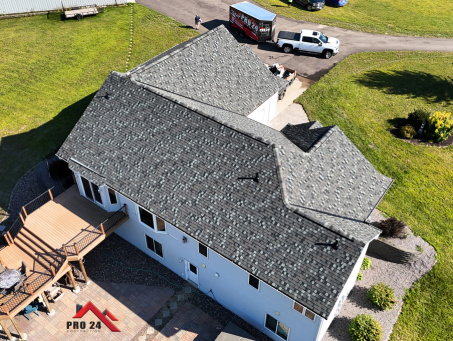In the world of roofing, some components are more crucial than others in safeguarding your home from the elements. Among these key features is the roof valley—a fundamental yet often underappreciated element of a properly functioning roofing system.
Despite its subtle presence, the roof valley plays a pivotal role in directing water runoff and maintaining the overall integrity of your roof. These areas guide water runoff and protect your home from leaks, ensuring your roof performs its best even in the harshest weather conditions.
For homeowners considering a new roof installation or repair, understanding the importance of roof valleys can save you from costly damage down the road. In this guide, we’ll delve into the importance of roof valleys, explaining what they are and why they play a critical role in your roof’s overall performance.
You’ll discover how to select the best materials, including the rising trend of valley metal roof options, to enhance durability and functionality. Additionally, we’ll provide practical maintenance tips and insights on how to spot signs that repairs or replacements may be necessary, ensuring your roof remains in peak condition.
What Is a Roof Valley?
A roof valley is the angled intersection where sloping roof planes converge, forming a distinctive “V-shaped” channel. This essential feature directs rainwater and melting snow off the roof and safely into the gutters, playing a key role in water management.
When properly designed and installed, roof valleys prevent water from pooling or infiltrating the roof structure, protecting against leaks, moisture buildup, and potential structural damage.
There are two main types of roof valleys:
-
Open Roof Valleys:
-
-
- In open valleys, a strip of metal, often called a valley metal roof, is installed to protect the area.
- This metal strip remains visible, making it easy to monitor for wear and tear.
-
-
Closed Roof Valleys:
-
- Cut valleys or Closed valleys use shingles to cover the area, creating a seamless appearance.
- While they offer a cleaner aesthetic, they may be more prone to wear and require careful installation to prevent leaks.
Why Are Roof Valleys Important?
1. Water Drainage
The primary function of roof valleys is to direct water off your roof efficiently. Without them, water could pool in vulnerable areas, leading to leaks, mold, and even structural damage.
2. Protecting Vulnerable Areas
Roof valleys are one of the most vulnerable parts of any roof due to the high volume of water they handle. Properly installed valley roofing materials help ensure these areas remain durable and watertight.
3. Aesthetic Appeal
Although functionality is the primary concern, well-designed roof valleys can also enhance your roof’s overall appearance. Options like a valley metal roof can provide a sleek and modern touch.
4. Extending Roof Lifespan
Properly maintained roof valleys contribute to the longevity of your entire roofing system. By effectively channeling water away, they reduce the risk of damage and help maintain the integrity of other roofing components.
Choosing the Right Valley Roofing Material
When it comes to valley roofing, selecting the right materials is essential to ensure long-lasting durability, optimal performance, and reliable protection for your roof.
The valley, where two roof slopes meet, is a critical area that requires extra attention because it channels water runoff. This means the materials used in valley roofing must be able to withstand constant exposure to water, debris, and fluctuating weather conditions.
Each type of valley roofing material comes with its own unique set of benefits, making the choice highly dependent on several key factors, including the local climate, your overall budget, and the desired aesthetic for your property.
For example, metal valley flashing is a popular choice due to its superior water resistance and ability to handle heavy rain or snow, making it ideal for regions with harsh weather. On the other hand, woven valleys or closed-cut valleys, which use shingles or other roofing materials to create a seamless look, may appeal more to homeowners focused on aesthetics.
In addition to functionality and style, budget considerations also play a major role. Some materials may have a higher upfront cost but offer exceptional longevity and reduced maintenance, making them a cost-effective solution in the long run.
Conversely, more affordable materials may suit short-term needs but might require more frequent repairs or replacements.
Ultimately, the right material for valley roofing should align with your specific needs and priorities. Whether you prioritize durability, visual appeal, or cost-effectiveness, consulting with a roofing professional can help ensure that the valley areas of your roof remain protected and functional for years to come.
With careful selection and proper installation, you can enhance both the performance and longevity of your roofing system.
1. Metal Roofing for Valleys
- Valley metal roofs are a popular choice due to their durability and water resistance.
- Common metals used include aluminum, steel, and copper.
- Metal roofing for valleys is ideal for areas with heavy rainfall or snow, as it ensures water flows smoothly off the roof.
2. Asphalt Shingles
- A cost-effective option often used in closed roof valleys.
- While they offer a seamless look, shingles may wear down faster in high-water flow areas, requiring more frequent maintenance.
3. Tile Roofing
- Tile roofs often incorporate metal valleys for added protection.
- These are highly durable but require professional installation to avoid water seepage.
4. Synthetic Materials
- Newer synthetic materials are designed to mimic the look of traditional roofing while offering enhanced durability.
- These can be a great option for homeowners seeking low-maintenance solutions for their roof valleys.
Benefits of Valley Metal Roofs
Choosing a valley metal roof has become increasingly popular due to its superior performance and aesthetic appeal. Here are some of the key benefits:
1. Durability
Metal roofing for valleys is highly resistant to rust, corrosion, and impact damage, making it an excellent choice for areas prone to extreme weather.
2. Low Maintenance
Unlike shingles, which may require periodic replacement, metal valleys often last as long as the roof itself with minimal upkeep.
3. Energy Efficiency
Reflective metal surfaces can help reduce heat absorption, improving your home’s energy efficiency and reducing cooling costs.
4. Modern Aesthetics
A valley metal roof can add a sleek, contemporary look to your home, enhancing curb appeal.
Typical Roof Valley Issues
While roof valleys are designed to handle large amounts of water, they are also one of the most common areas for roofing problems to occur. Here are some issues homeowners may encounter:
1. Leaks
Improperly installed or damaged roof valleys can allow water to seep into the underlying roof structure, leading to leaks and water damage.
2. Debris Buildup
Roof valleys are prone to accumulating debris, which can block proper water drainage and significantly heighten the risk of leaks and water damage.
3. Damage from Regular Use and Exposure
The constant exposure to the elements and the high volume of water runoff in roof valleys, particularly open valleys, can lead to the gradual deterioration of shingles or metal over time. This wear and tear can compromise the valley’s effectiveness and increase the risk of leaks or damage.
4. Ice Dams
In colder climates, ice dams can form in roof valleys, preventing proper water drainage and causing water to back up under the shingles.
Maintaining Your Roof Valleys
Proper maintenance is essential to keep your roof valleys in good condition. Here are some tips to ensure they function effectively:
1. Regular Inspections
Schedule annual inspections with a professional roofing contractor to identify potential issues early.
2. Remove Debris Regularly
Keep roof valleys free of leaves, twigs, and other debris to maintain optimal water drainage and prevent blockages that could lead to leaks or water damage.
3. Check for Damage
Inspect for signs of deterioration, such as cracked shingles, rusted metal, or other visible damage, and take swift action to repair these issues before they escalate into more significant problems.
4. Trim Nearby Trees
Overhanging branches can drop debris into your roof valleys and scratch the surface, causing unnecessary wear.
5. Prevent Ice Dams
In colder climates, ensure your attic is well-insulated and ventilated to minimize the risk of ice dams forming in your roof valleys.
Signs Your Roof Valleys Need Repair or Replacement
Recognizing the signs of damage in your roof valleys can save you from more significant issues down the road. Here’s what to watch for:
- Water Stains or Leaks. Water damage inside your home is often a sign of failing roof valleys.
- Shingle Damage. Missing, curling, or cracked shingles near roof valleys indicate potential issues.
- Rust or Corrosion. Visible rust on a valley metal roof should be addressed immediately.
- Sagging Valleys. Structural issues in the roof valley area may cause sagging, which requires professional repair.
Professional Installation and Repair
Ensuring your roof valleys are properly installed and maintained is essential to the overall health of your roofing system. A professional roofing contractor has the expertise to handle everything from material selection to installation and repair. At Pro 24 Contracting, we specialize in valley roofing solutions tailored to your home’s needs.
Why Choose Pro 24 Contracting?
- Experienced Team: Our team has extensive experience working with various roofing materials, including valley metal roofs and asphalt shingles.
- Quality Materials: We use only high-quality materials to ensure your roof valleys stand the test of time.
- Customized Solutions: Whether you need a repair or a full roof replacement, we provide personalized recommendations to fit your budget and preferences.
Final Thoughts on Roof Valleys
Roof valleys are more than just a structural feature—they’re a critical component of your home’s defense against water damage. Understanding the importance of these areas and investing in high-quality valley roofing materials, such as a valley metal roof, can protect your home for decades to come.
By choosing durable materials, performing regular maintenance, and addressing issues promptly, you can ensure your roof valleys remain in excellent condition.
If you’re unsure about the state of your roof valleys or need professional assistance, Pro 24 Contracting is here to help. Contact us today for a consultation and let our experts ensure your roof provides the protection your home deserves!

